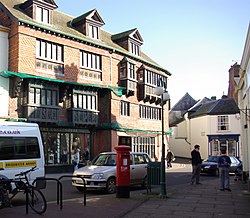Wiveliscombe
| Wiveliscombe | |
| Somerset | |
|---|---|
 Court House, Wiveliscombe | |
| Location | |
| Grid reference: | ST080279 |
| Location: | 51°2’35"N, 3°18’49"W |
| Data | |
| Population: | 2,670 (2001) |
| Post town: | Taunton |
| Postcode: | TA4 |
| Dialling code: | 01984 |
| Local Government | |
| Council: | Somerset West and Taunton |
| Parliamentary constituency: |
Taunton Deane |
Wiveliscombe is a tiny town in Somerset, 9 miles west of Taunton. The town had a recorded population of just 2,670 in 2001. The parish includes the nearby hamlet of Maundown.
Wiveliscombe is a former borough, market and cloth making town just 5 miles from the border between Devon and Somerset. It is at the foot of the Brendon Hills and acts as a gateway to Exmoor.
The town used to have a station on the Devon and Somerset Railway, but this closed in 1966.
History
Northwest of the town are Clatworthy Camp an Iron Age hill fort and Clatworthy Reservoir. Nearby is Elworthy Barrows an unfinished Iron Age hill fort rather than Bronze Age barrows.[1] The Neolithic hillfort at King's Castle is under a mile east of the town.
The Town Hall was built in 1840 by Richard Carver for Lord Ashburton. It housed a fish market, a butchers’ market and a pig market with an assembly room above them. It is a Grade II listed building.[2] It was bought by The Cooperative Society in 1929 and converted to shops, with the hall being left unused. Plans have now been drawn up for the creation of an Arts, Media, Cultural and Heritage Venue.[3]
In 2010 a new 10 Parishes Centre was announced which will provide a new community facility alongside the Children’s Centre being built at Croft Way.[4]
Churches

The Church of St Andrew dates from 1827-9 and was built from red sandstone with Hamstone dressings, although the font is octagonal and originated in the 14th century. The architect was Richard Carver. The church has been designated as a Grade II* listed building.[5]
Within the churchyard is a 14th-century Sandstone cross.[6]
The oldest place of worship in Wiveliscombe is the Congregational Chapel in Silver Street, built in 1708 as the Independent Chapel. It joined the Congregational Union of England and Wales in 1838, and today is home to the Wiveliscombe Evangelical Congregational Church. This chapel was built because the Independent Meeting House (built in 1689 after the Act of Toleration) had become too small. This earlier Meeting House was demolished sometime after the First World War, when North Street Motors was built on the site. This has now closed, and the premises are currently being used as a garden shop.
Outside links
References
- ↑ Barrow, "Hllforts and hilltops 1000BC - 1000AD" in Aston and Burrow, The Archaeology of Somerset (1982)
- ↑ National Heritage List 1307454: Town Hall
- ↑ "Wiveliscombe town hall". Somerset Rural Renaissance. http://www.somerset-rural-renaissance.co.uk/wiveliscombe-town-hall.html. Retrieved 14 May 2010.
- ↑ "Building links at Wiveliscombe". Somerset Rural Renaissance. http://www.somerset-rural-renaissance.co.uk/projects-building-links-wiveliscombe.html. Retrieved 14 May 2010.
- ↑ National Heritage List 1177072: Church of St Andrew
- ↑ National Heritage List 1177103: Churchyard cross